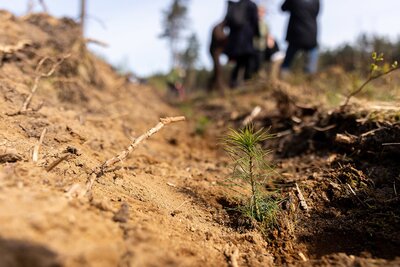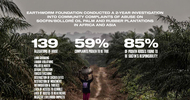Eyeing an emerging market: firms plant trees for CO2 credits in Lithuania
by Edgaras Savickas
A Lithuanian company Arbonics is trying to get owners of unused land to plant more trees. In return, they are looking to earn thousands of euros in carbon credits. “We are talking about earning 15,000 euros per hectare over the next 20 years,” said Arbonics CEO Kristjan Lepik.
One carbon credit is equivalent to 1 tonne of stored or unabsorbed CO2. According to Lepik, the credits are bought by various international companies, including Microsoft, to be climate-neutral.
“This is one of the fastest-growing markets in the world. Nobody knows exactly where we will be in 2030, but seeing how the European Commission requirements are pushing companies towards that, I think there are around 1,000 companies globally doing it now, and there will be 3,000 to 4,000 in a few years,” he said.
The cost of CO2 credits is set by the market. Generally, it is possible to earn 15,000 per hectare over the next two decades.
“Our company needs to invest around 20 million euros before it can generate any income. If you ask me how much I believe this, it is obvious,” Lepik said.
Arbonics estimates that there are currently over 150,000 hectares of unused land in Lithuania.
“We currently have almost ten clients in Lithuania, but we have just started operations. Arbonics, which operates in Estonia, Finland, Latvia, and Lithuania, has worked with 5,000 land managers,” Lepik said, adding that they plan to expand to Sweden and Poland.
“As far as buyers are concerned, Microsoft, for example, has a team of 150 people working on this issue. You can imagine how hard they check all the details,” said the CEO of Arbonics. “They have a long list of requirements because if they make a mistake anywhere, they would be accused of greenwashing.”
One million trees to be planted
One of Arbonics' clients in Lithuania is INVL Sustainable Timberland and Farmland Fund II. According to its managing partner, Martynas Samulionis, they have already planted around 200 hectares of mixed forest and 750,000 trees in total.
“We believe that by the end of 2025, we will have planted over 1 million trees. We are mainly planting birch, Scots pine, and alder,” he said.
Lepik added that Lithuania has a great potential for reforestation.
“In Sweden, it is much lower and we will offer a different product there – 78 percent of Sweden is already forest. I would also like to point out that trees grow differently in Lithuania than in Estonia. Lithuania is in a better position, we are further south and the trees grow faster. We have built models to show how fast trees grow in Lithuania, the land is different here.
As the climate warms up, trees migrate north. It used to take a tree 20 years to grow in the south of Poland, but now it takes the same amount of time in Lithuania,” Lepik said.
Owners of existing forests will not only be able to earn from CO2 credits but could earn from the wood they sell when the forest matures, ie after 40, 60, or 80 years.
Does this mean that the CO2 accumulated until then will be released into the air? Gabija Tamulaitytė, an environmental expert at the Baltic Environment Forum, said not necessarily.
“It is important to see where the wood is used afterwards. If it’s used as firewood, then all the CO2 that has been accumulated for 50 or 60 years is released back into the atmosphere,” she said.
“But maybe the wood will be used for construction, which will mean it keeps the CO2 in. In that case, there is a double benefit, because we are storing CO2, the forest has gained a lot of biodiversity and people can still make money from it,” she said.
The environmentalist added that there are also better ways to store CO2.
“Forests are not the only ecosystems that store carbon – wetlands store the most CO2. These ecosystems should also be looked at, because a forest can be destroyed very easily, for example by fire. Wetlands can last for thousands of years and the carbon in them will not disappear,” Tamulaitytė said.
She also called for the preservation of grasslands, which are also valuable and should not be reforested just for the possibility of making money from CO2 credits.
“It is very important that when we talk about such projects, they take place where they should. It should not be the case that wetlands are drained and then reforested to get credits,” said Tamulaitytė.












